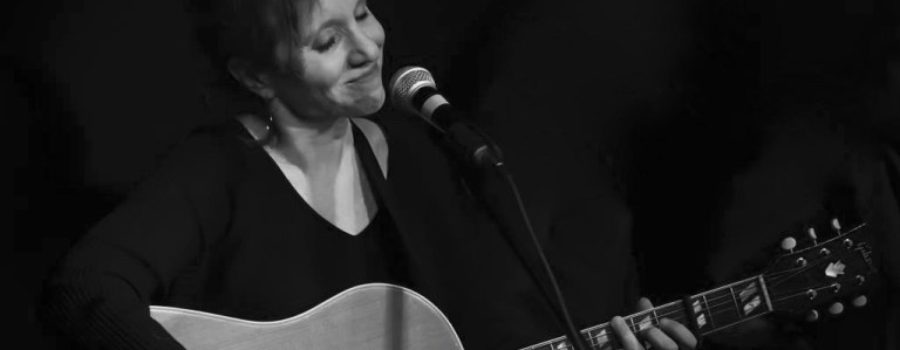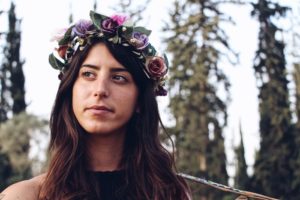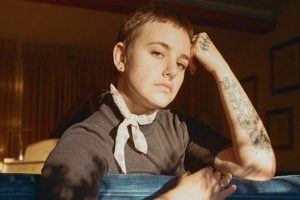Janie Barnett was a little girl growing up on the purest of sounds, Americana. Throughout her career she’s known many styles – even Reggae. Eventually finding her way back to her roots we talked about everything from her start in Virginia to her time in New York City to her current album, You See This River.
Kendra: Do you ever feel like if you’d grown up elsewhere you would have never found your love of Americana and Bluegrass?
Janie Barnett: Broadly speaking, I firmly believe in environmental factors in every human’s development, and certainly in the life of an artist we are veritable sponges! My upbringing in northern Virginia had a particular kind of influence. I was exposed to the political-cultural environment of Washington through my family members’ work lives. This informed my civic interests and my language skills. And the swirl of American roots music in DC and the surrounding Virginia festivals impacted my musical sensibilities.
At the same time, I was studying classical guitar with a prominent mentor in DC, I was going to festivals and working at the Smithsonian’s American Folklife Festival. I think the Folklife festival had a tremendous influence on me, seeing those artists of every kind close up. Musicians, weavers, apple growers. And at home? I was very lucky there as well. My father was a great music lover and had LPs of Mozart, Billie Holiday, the Weavers, Danny Kaye. It ran the gamut. My Dad loved to blast Eine Kleine Nachtmusik in the living room and sit in his chair to release the pressure of his newsman’s day.
Kendra: Perhaps you would have because it seems like you’ve always marched to the beat of your own drum. After high school, you were in a roots reggae band. Who does that? You and it’s great. You also found your way to New York City. You’d lived elsewhere before that, but how was it being a girl from VA and now being in a place as fast-paced as NYC? My fiance’s family lives in VA and it just seems like night and day.
Janie: The environment in Northern Virginia is a study in contrasts – “real Virginia” and cosmopolitan Washington. Many of us on the borders of DC experience this dichotomy. And honestly, this duality has been present my entire life. In and out of elite schools to be a working “slumming” musician. Left brain, right brain. Defector from Harvard and house cleaner.
My mecca to the urban areas of Cambridge and then NYC were scary, but I felt, as many do, a powerful pull to these centers of buzzing creative activity. It was something I craved. I will say, though, that those early years of excitement caused me to want to explore just about every genre. That meant I did lose track of my first love affair with true roots music. That double album of Will The Circle Be Unbroken, which was the gateway to John Hartford and other “Newgrass” artists of the time, it remained in my collection. But it took literally two decades for me to remember that love of layered stringed instruments and cluster harmonies.
Kendra: What part did New York City play in creating the artist you are today?
Janie: NYC was a mecca for me. I had to come. That being said, one could question whether it was the best place for me to come as a singer-songwriter at that time in the business. But I had a couple of friends here and I knew the city a little bit. And it was the place where folk music had happened. I knew that meant something to me.
Ironically, New York gave me the gift of being a successful freelance life where I could exercise my skills, support my family life, be part of a talent-filled musical community. I made life-long friends in that business. One could say that the freelance life might have hindered my artist work.
I argue I needed the amount of time I took to find my vision, my authentic signature. Artists in any field feel the development on a continuum. I hate to say it, but the old adage, everything for a reason, it rings very true for me. New York has taught me about performing under pressure, about striving for a high level of skill, about community, about the beauty of shared urban life.
Kendra: It’s the artist that released her sophomore album recently, You See This River. You noted that this album reflects when you stopped running from yourself. What was the number one feeling you felt every time you stepped into the studio knowing that you weren’t running anymore?
Janie: One word comes immediately to mind: relief. I could breathe fully! I finally came to a point in my life where I had the courage to just explore, to not look over my shoulder, and to allow myself to, at first, not know, and then know. We spend too much time second-guessing ourselves and others’ impressions of us. I can honestly say I find it hysterical that it took me as long as it did to reach this point in my creative life. I’ve let go of beating myself up for the timetable, the missteps, the isolation. And at that point of acceptance and freedom, I actually started to hear and feel new songs coming out of me that I connected to. It was a relief.
Kendra: You also noted that this album has a lot of universal emotions. Which is most important out of those and which song can we hear that on most?
Janie: There are pieces of my themes woven into every song, so there is no one song that embodies all the themes. I have always been fascinated by the feeling of nostalgia; a longing that is at times undefined. Then I came upon an interview with Daniel Day Lewis, in which he said that he believed nostalgia was primal. Ah, that’s it, I thought. It’s in our DNA. Who knows why.
I used to think that if we could satisfy our passions both professionally and personally, this longing could cease. But it turns out it doesn’t. We, humans, long for something. Maybe it’s knowing something like God. But back to the songs! Reflected in songs like “Wrap Me Up,” “This Small World,” and “Walk It Out To You.” I’m touching on the idea that there are people in your life you feel destined to be within some capacity, with whom you share the journey. And often you know it in the instant of meeting them.
The nature of that relationship is not always clear and sometimes remains ambiguous throughout a lifetime. I want to accept that. “You See This River,” the title track, which I wrote several years before the other songs, speaks about the messiness, the persistence of our beings. As I like to say the pig-headedness of we humans, floating on the beautiful and terrible journey of the river. And acceptance, forgiveness, unconditional commitment, as in “Sweet Thursday,” “How You Are,” and “Good Crazy Thing,” even the hymn, “How Can I Keep From Singing.” They are about faith and generosity of spirit. Don’t be afraid to say “I’m in this.”
Kendra: I feel it’s important to touch on your career as an associate professor at Berklee for voice. When you teach, is it coming from an educational standpoint or an artist’s who knows first hand about recording and performing?
Janie: A wonderful question. I was brought to Berklee because of my professional experience. To share with the students my knowledge as a singer-songwriter, a self-accompanying artist, a bandleader, a freelance singer who has had to sight-read on years of recording sessions. So every aspect of my life experience is in play as I mentor these kids. I had always had a small teaching practice throughout my career as well, having been taught by a brilliant practitioner who really taught me how to teach voice technique.
The Berklee students need concrete musicianship skills. I love drilling those skills into them, but they also need, and of course, want guidance in terms of living a professional life. The most important aspect of teaching might be anything I can do to facilitate their finding their own creative process, setting the right environment for them to come out with their own authentic voice. In terms of my own journey, I have set that as a priority for my engagement with the students.
Kendra: What is the number one thing being a professor has taught you personally about people as overall performers?
Janie: You cannot dictate to an emerging artist what they should or shouldn’t do. You have to offer them tools to help themselves find their own vision. I’m dead set against telling them explicitly what is right or wrong in their development.
When we workshop songs, I try to offer them a window into what I’m “getting” from the words the writer has chosen, the musical environment. And then I ask, “is that what you intended?” I ask my performing songwriters to read a wonderful little book by Stephen Pressfield called The War Of Art. Then I ask them to write a response paper to a passage in that book. I want them to reflect on their own process.
You can’t imagine the number of papers through the years that become intense dialogues about family issues, pressures, self-doubt, fear. These are things we all face. An artist cannot create without looking at those questions. Performers bring a lifetime of stories to every performance. The braver and bolder we all are in understanding our own stories, the more powerful and truthful our performances will be. Even if we’re singing “Happy Birthday.”
Kendra: With 2017 ending soon, do you have any plans already in place for 2018?
Janie: I’m just overwhelmed by the response to this project. I call it “the little indie that could.” I just want to keep getting the music out to people, and building upon the live shows we’ve started to get in this latter part of the year. We’ve got a show at City Winery in New York on Dec 3rd. I didn’t just want to do a set of songs from the album, but also invite other artists to share the hour and a half set; we’ll do our own songs and collaborate together on some songs.
So I’m curating the show, a la the Transatlantic Sessions that Jerry Douglas has been doing over the years. I’m excited about this and hope I can continue this as a series, introduce fans to different artists and encourage future collaborations. Beyond that, I hope to get off the east coast and do some shows in other parts of the country where independent radio DJs have boldly played the record.
Kendra: Lastly, here at ZO, we’re all about all the creative outlets. With that, if you had to compare You See The River to a famous work of art – which would it be and why?
Janie: My answer is a bit confusing, but perhaps your readers can help me solve the puzzle of this. I was given a print on canvas by a special person in my life. It was a “found” piece of art. He was told it was a representation of a Hockney, a painting of what I perceived to be a mother and daughter on a couch. The girl was lying down and she had a cast on her leg, from what I remember. The colors were amazing, rich and warm and inviting. The image conjured such emotions in me.
The longing of both females, the love, and trust between them. Longing as well as contentment. Perhaps one was imagining building a new suspension bridge or finding a cure for disease. Perhaps one was dreaming of being kissed by that special one. Or had a craving for chocolate and wished the other would get up and get it for them.
The artwork was lost at some point, and I’ve never found the image online. If it’s actually a Hockney, it’s an obscure one. Maybe I’m wrong and it was another artist. I’ve never forgotten that work. It spoke to me as a kind of journey of hearts and minds, enveloped in this rich color and texture. If I could approach that kind of engagement with the listener on even one song, I’d be satisfied.






